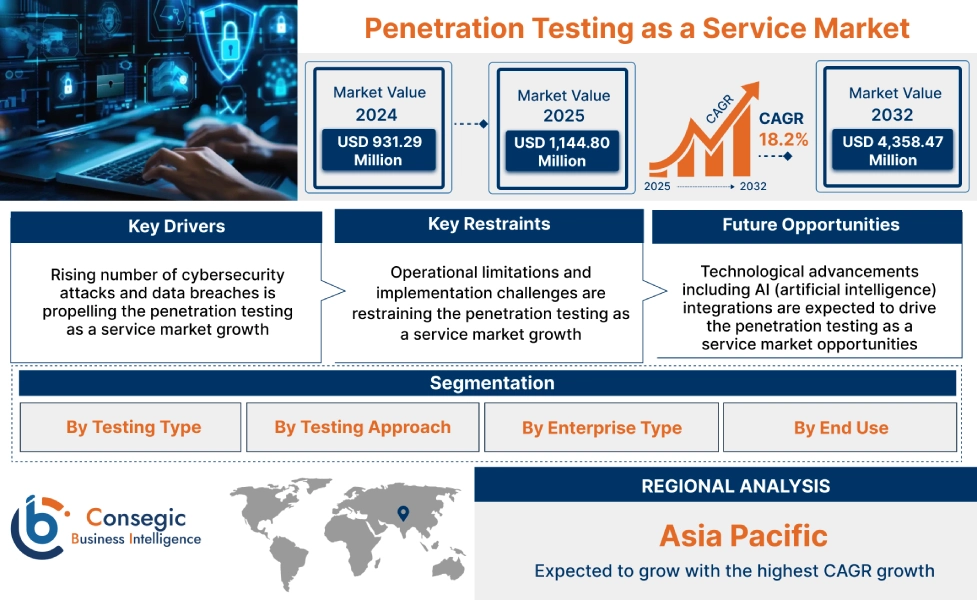Penetration Testing as a Service Market Size:
Penetration Testing as a Service Market size is estimated to reach over USD 4,358.47 Million by 2032 from a value of USD 931.29 Million in 2024 and is projected to grow by USD 1,144.80 Million in 2025, growing at a CAGR of 18.2% from 2025 to 2032.
Penetration Testing as a Service Market Scope & Overview:
Penetration testing as a service (PTaaS) delivers penetration tests through a cloud-based platform, combining automated tools with human expertise for identifying and exploiting vulnerabilities in systems and applications. It enables relatively frequent, faster, and more cost-effective testing in comparison to traditional methods while facilitating continuous or point-in-time testing, often on a subscription basis. Additionally, penetration testing as a service offers several benefits, including continuous testing, real-time visibility of vulnerabilities, fast remediation support, improved collaboration, and cost-efficiency, among others.
How is AI Transforming the Penetration Testing as a Service Market?
AI is reshaping the global Penetration Testing as a Service (PTaaS) market by making security assessments faster, smarter, and continuous. AI-powered tools automate reconnaissance, vulnerability scanning, and lower testing time from weeks to mere hours. Machine learning enhances accuracy, reduces false positives, and helps prioritize critical risks. Generative AI assists in creating adaptive attack simulations and even automates report writing, allowing human experts to focus on high-level strategy. These systems can learn from previous engagements to evolve testing methods and simulate emerging threats. Overall, AI is making PTaaS more scalable, cost-effective, and proactive transforming cybersecurity from reactive checks to ongoing, intelligent defense.
Penetration Testing as a Service Market Dynamics - (DRO) :
Key Drivers:
Rising number of cybersecurity attacks and data breaches is propelling the penetration testing as a service market growth
The current business landscape is witnessing a significant increase in the volume of data breaches and cybersecurity threats from cyber criminals. Business enterprises are increasingly exposed to data loss and security breaches, where sensitive information is stolen or compromised. Moreover, organizations are investing in proactive security measures such as penetration testing to identify vulnerabilities before hackers can exploit them. As a result, business enterprises are seeking reliable and cost-effective penetration testing solutions such as PTaaS for protecting their sensitive information. PTaaS offers a cost-effective and scalable alternative to traditional penetration testing solutions, making it an ideal option for business enterprises, particularly small and medium enterprises (SMEs).
- For instance, according to the Identity Theft Resource Center (ITRC), the total number of data breaches in the United States reached 3,205 breaches in 2023, representing a substantial increase of 78% in comparison to 1,801 data breaches in 2022.
Therefore, the increasing number of data breaches and cybersecurity attacks is driving the need for penetration testing solutions, in turn propelling the penetration testing as a service market size.
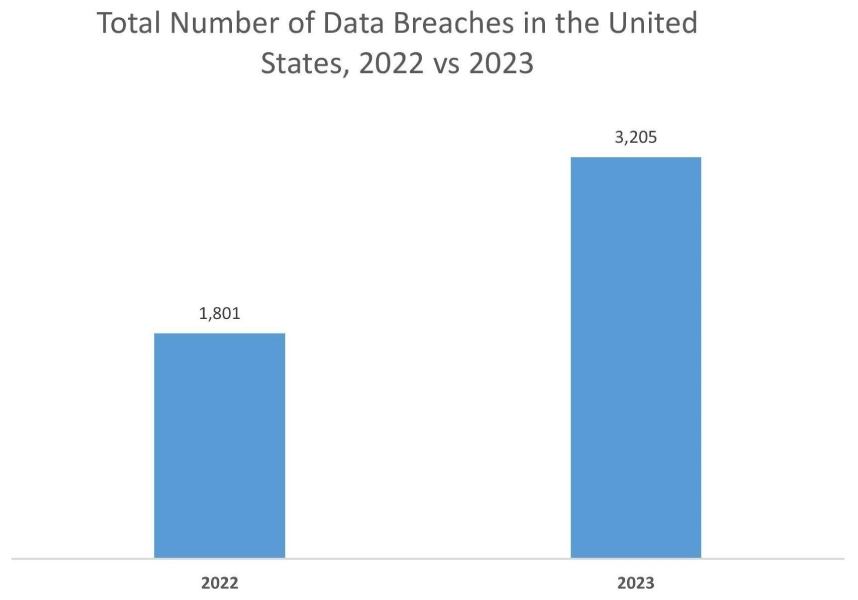
Key Restraints :
Operational limitations and implementation challenges are restraining the penetration testing as a service market growth
Penetration testing as a service is associated with certain operational limitations and challenges, which are among the key factors limiting the market. For instance, the primary limitations related to PTaaS include limited scope, potential for false positives, third-party restrictions, complexities related to sensitive data retention and handling, and others.
Moreover, standard PTaaS offerings may not be capable of completely addressing the distinct security needs for organizations with complex architectures and may require customizations. Additionally, automated testing can generate false positives, requiring manual review and potentially disrupting operations. Thus, the aforementioned factors are hindering the penetration testing as a service market expansion.
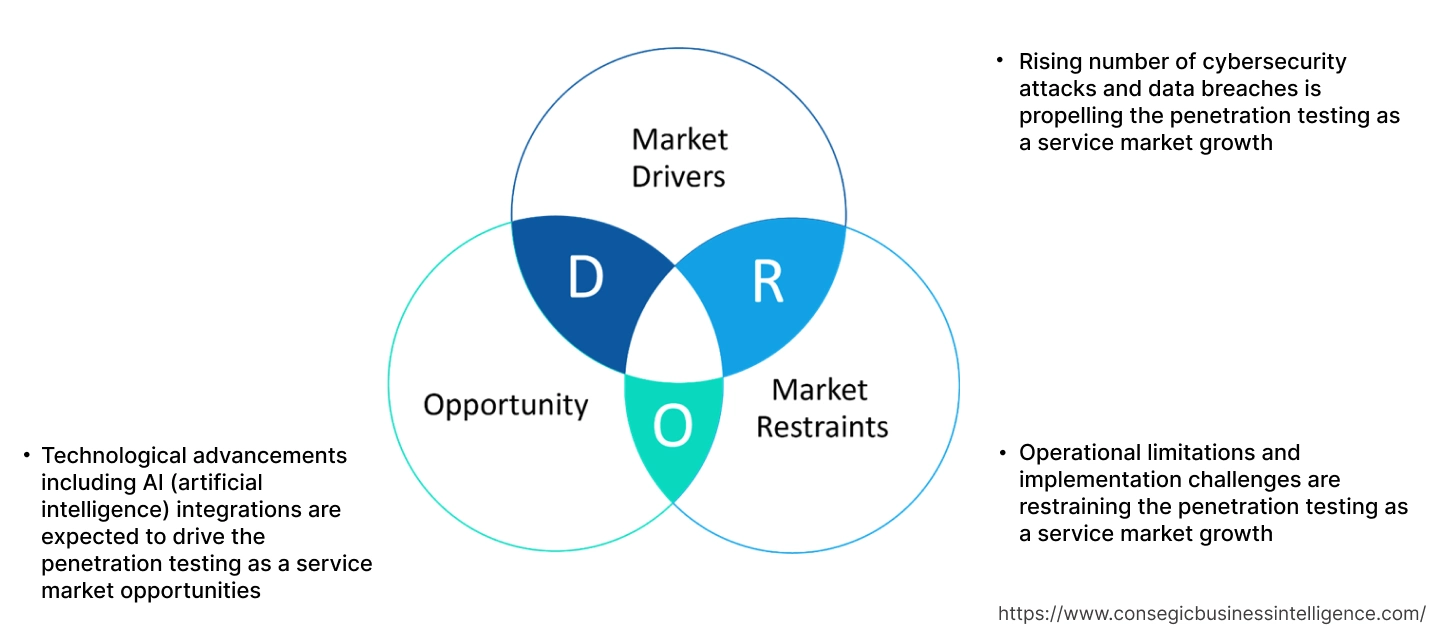
Future Opportunities :
Technological advancements including AI (artificial intelligence) integrations are expected to drive the penetration testing as a service market opportunities
AI-powered penetration testing leverages artificial intelligence for automating and enhancing the process of identifying and exploiting vulnerabilities in systems. This approach offers faster, more efficient, and continuous security assessments, which helps in improving the overall security. Moreover, AI can automate tasks such as vulnerability scanning, report generation, and others, which allows human testers to focus on more complex and strategic aspects of security. Additionally, AI-powered penetration testing offers several benefits, including faster testing speed, continuous monitoring, improved accuracy, increased efficiency, and others.
- For instance, in March 2025, Strike LLCraised USD 13.5 million in early-stage funding for expanding its AI-powered continuous penetration testing solution in the United States and Brazil.
Hence, as per the analysis, technological advancements such as AI integration with penetration testing solutions are projected to boost the penetration testing as a service market opportunities during the forecast period.
Penetration Testing as a Service Market Segmental Analysis :
By Testing Type:
Based on testing type, the market is segmented into network penetration testing, web and mobile application penetration testing, client side penetration testing, wireless penetration testing, social engineering penetration testing, and others.
Trends in the testing type:
- Rising adoption of network penetration testing services in business enterprises for identifying security gaps, enhancing overall security, and reducing the risk of financial and reputational damage from cyberattacks is driving the market.
- Increasing deployment of PTaaS for web and mobile application testing to identify any potential vulnerabilities, their impact, and recommendations for remediation is boosting the market.
The network penetration testing segment accounted for the largest revenue share in the overall market in 2024.
- In network penetration testing, ethical hackers simulate cyberattacks on a network to identify vulnerabilities and security flaws before malicious hackers can exploit them.
- Network penetration testing involves systematically probing the network's defense to assess its security posture and identify any weaknessesin the network's infrastructure and systems that could be exploited.
- Moreover, network penetration testing offers several benefits, which include identifying security gaps, enhancing overall security, and reducing the risk of financial and reputational damage from cyberattacks.
- For instance, Redscan Cyber Security Limitedis a PTaaS provider that offers network penetration testing services in its solution offerings. The company’s network testing services enable organizations to evaluate their network and identify and exploit a broad range of security vulnerabilities.
- Thus, according to the analysis, the rising advancements related to network penetration testing services are driving the market growth.
The web and mobile application penetration testing segment is anticipated to register a significant CAGR during the forecast period.
- Web application penetration testing refers to a security assessment that simulates cyberattacks on a web application to identify vulnerabilities before malicious hackers can exploit them.
- Meanwhile, mobile application penetration testing is the process of simulating cyberattacks on mobile applications to identify vulnerabilities.
- Additionally, web and mobile application penetration testing involves testing various aspects of the application, including authentication, input handling, server configurations, code, architecture, data storage, and network communication to discover weaknesses that could compromise data or functionality.
- For instance, Synack offers PTaaS in its solution offerings, which also includes web and mobile application penetration testing services. The company’s application penetration testing services are applicable across web, mobile, and cloud applications, which further helps in identifying any potential vulnerabilities, their impact, and recommendations for remediation.
- Hence, the above factors are projected to boost the market during the forecast period.
By Testing Approach:
Based on testing approach, the market is segmented into black box, white box, and gray box.
Trends in the testing approach:
- Increasing adoption of black box testing due to its several benefits, includingrealistic attack simulation, unbiased testing, early vulnerability detection, user-centric testing, and others, is driving the segment growth.
- There is a rising trend towards adoption of gray box testing, due to its ability to enhance test coverage, discover hidden defects, and offer higher efficiency by leveraging partial system knowledge to focus on high-priority areas.
Black box segment accounted for a substantial revenue in the overall penetration testing as a service market share in 2024.
- In black box penetration testing, testers evaluate a system's security without prior knowledge of its internal structure or code. The tester typically acts as an external attacker with no prior knowledge of the target system's internal workings.
- Moreover, black box penetration testing approach simulates an external attacker's perspective, focusing on publicly available information and external interfaces to identify vulnerabilities.
- It is a vital method for assessing a system's security posture from an outsider's viewpoint by imitating real-world attack scenarios.
- Additionally, black box testing offers several benefits, includingrealistic attack simulation, unbiased testing, early vulnerability detection, user-centric testing, and others.
- Consequently, the above benefits of black box penetration testing are further driving its adoption, in turn propelling penetration testing as a service market trends.
The gray box segment is anticipated to register the fastest CAGR during the forecast period.
- Gray box penetration testing approach combines elements of both black box and white box testing.
- In gray box testing method, testers have partial knowledge of the target system, which may include information associated with login credentials, system architecture diagrams, or specific application details.
- Moreover, gray box testing is capable of enhancing test coverage, discovering hidden defects, and it is relatively more efficient than other testing methods as it can leverage partial system knowledge to focus on high-priority areas.
- Additionally, this method is particularly useful for simulating real-world attack scenarios and identifying vulnerabilities that might be missed in other testing approaches.
- Consequently, the aforementioned factors are projected to drive the adoption of gray box testing, in turn boosting the market growth during the forecast period.
By Enterprise Type:
Based on enterprise type, the market is segmented into large enterprise and small and medium enterprise (SME).
Trends in the enterprise type:
- Increasing trend in the deployment of PTaaS in large enterprises to enhance security posture, streamline processes, and improve overall risk management is driving the market.
- Factors including rising investments in the development of small and medium enterprises and increasing adoption of PTaaS in SMEs for facilitating a cost-effective approach to identify and address vulnerabilities are key trends driving the small and medium enterprise segment growth.
Large enterprise segment accounted for the largest revenue in the penetration testing as a service market share in 2024.
- Large enterprises benefit significantly from PTaaS, due to its ability to enhance security posture, streamline processes, and improve overall risk management.
- PTaaS offers continuous, on-demand testing while providing real-time insights into vulnerabilities and facilitating faster remediation as compared to traditional testing methods.
- Moreover, large enterprises primarily use PTaaS as a cost-effective and efficient approach for securing their data, applications, and infrastructure through a cloud-based model.
- Further,PTaaS solutions can easily scale to accommodate the growing and evolving needs of large enterprises, providing access to skilled pen testers and advanced testing capabilities.
- Therefore, the increasing adoption of PTaaS in large enterprises is driving the penetration testing as a service market trends.
Small and medium enterprise (SME) segment is anticipated to register the fastest CAGR during the forecast period.
- Small and medium enterprises are companies that typically maintain workforce, revenues, and assets below a certain threshold.
- Moreover, SMEs usually account for the majority of the businesses that are operating across the world.
- Additionally, PTaaS offers a cost-effective and efficient approach for SMEs to identify and address vulnerabilities by leveraging a cloud-based platform and expert security testers.
- For instance, according to the U.S. Chamber of Commerce, the total number of small businesses in the United States reached 33.2 million in 2022, accounting for nearly 99.9% of total businesses in the U.S.
- Thus, the rising number of small and medium enterprises is expected to boost the adoption of PTaaS, in turn driving the penetration testing as a service market size during the forecast period.
By End Use:
Based on end use, the market is segmented into BFSI, IT & telecommunication, retail & e-commerce, government & public sector, healthcare, and others.
Trends in the end use:
- There is a rising trend towards the utilization of PTaaS in the BFSI industry for advanced threat protection, improved protection of financial transactions, compliance with regulatory standards, and maintaining operational resilience.
- Increasing adoption of PTaaS in the healthcare sector for protecting sensitive patient data and securing the growing number of connected medical devices and applications.
BFSI segment accounted for the largest revenue share of 24.78% in the overall market in 2024.
- BFSI (banking, financial services, and insurance) firms are one of the primary targets for cyberattacks, attributed to the sensitive nature of their transactions and data.
- PTaaS helps BFSI organizations maintain a continuous security posture, comply with regulations, and proactively address vulnerabilities before they can be exploited by malicious hackers.
- Moreover, the utilization of PTaaS solutions in BFSI sector offers several benefits such as advanced threat protection, improved protection of financial transactions, compliance with regulatory standards, and others.
- For instance, according to the Federal Reserve Board, there are approximately 2,160 large commercial banks in the United States as of March 2025.These banks have combined assets of USD 300 million or more, with numerous branches in the U.S as well as other countries.
- According to the penetration testing as a service market analysis, the growing BFSI sector is increasing the adoption of PTaaS, thereby driving the market.
The healthcare segment is anticipated to register the fastest CAGR during the forecast period.
- Healthcare organizations often handle vast amounts of sensitive patient data, making it a key target for cyberattacks. Moreover, the increasing utilization of IoT-connected medical devices in healthcare creates new possibilities for cyberattacks.
- PTaaS plays a crucial role in the healthcare sector for protecting sensitive patient data, ensuring compliance with regulations such as HIPAA(Health Insurance Portability and Accountability Act), along with securing the growing number of connected medical devices and applications.
- It provides healthcare organizations with a more efficient and effective way to identify and address vulnerabilities, in turn strengthening their overall security posture.
- Hence, the rising adoption of PTaaS in healthcare sector is projected to drive market growth during the forecast period.

Regional Analysis:
The regions covered are North America, Europe, Asia Pacific, Middle East and Africa, and Latin America.
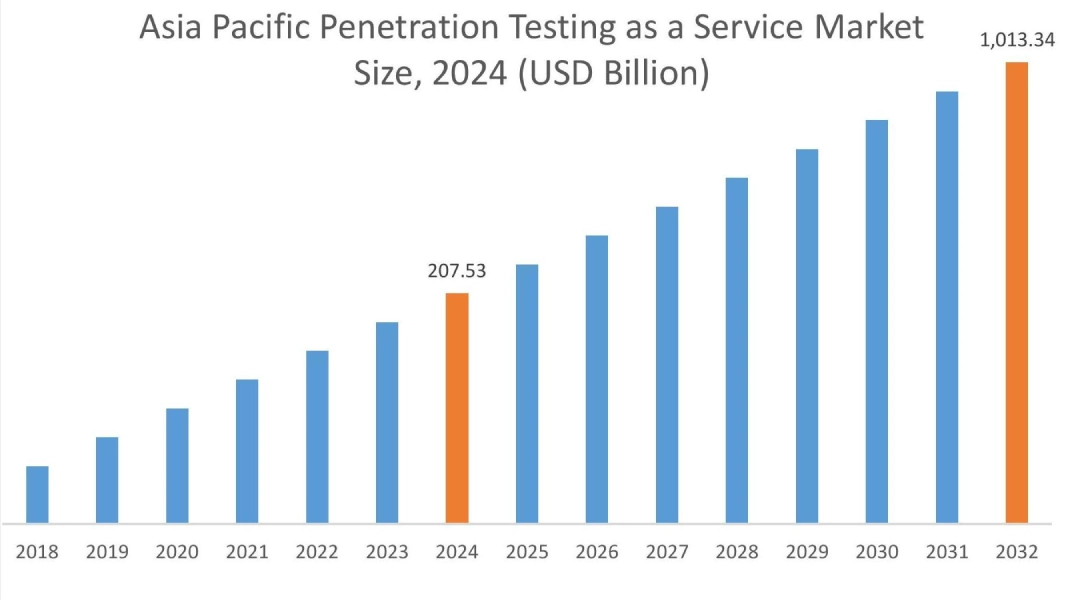
Asia Pacific region was valued at USD 207.53 Million in 2024. Moreover, it is projected to grow by USD 256.03 Million in 2025 and reach over USD 1,013.34 Million by 2032. Out of this, China accounted for the maximum revenue share of 34.42%. As per the penetration testing as a service market analysis, the adoption of PTaaS in the Asia-Pacific region is primarily driven by growing retail, IT & telecom, and government sectors among others. Additionally, the rising number of data breaches in government & public sector along with increasing demand for reliable and cost-efficient penetration testing solutions are further accelerating the penetration testing as a service market expansion in the region.
- For instance, in July 2022, Shanghai Municipal Police, a government organization based in China, witnessed a data breach that leaked the personal information of approximately one billion Chinese residents from the Shanghai police database stored in the cloud. The aforementioned factors are anticipated to drive market demand in the Asia-Pacific region during the forecast period.
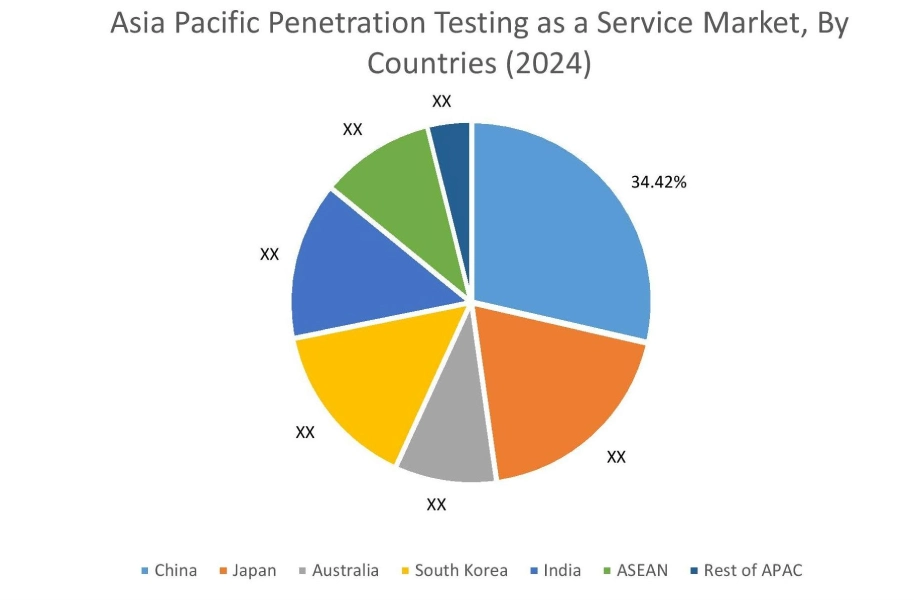
North America is estimated to reach over USD 1,791.33 Million by 2032 from a value of USD 383.78 Million in 2024 and is projected to grow by USD 471.66 Million in 2025. In North America, the growth of the penetration testing as a service industry is driven by rising investments in BFSI, retail, healthcare, and other sectors. Moreover, the rising adoption of advanced penetration testing solutions in BFSI sector for protecting sensitive customer data, complying with regulations, and maintaining operational resilience is contributing to the penetration testing as a service market demand in North America.
- For instance, in July 2022, Citi Bank launched its new Citi Commercial Bank in Canada, as part of the company’s global extension plan. Citi Commercial Bank offers a broad range of institutional solutions and products to meet the evolving needs of corporates. The above factors are further driving the market in North America.
Similarly, the regional analysis depicts that the growing healthcare, IT & telecom, and retail & e-commerce sectors along with rising need for cost-efficient penetration testing solutions among business enterprises are driving the penetration testing as a service market demand in Europe. In addition, according to the market analysis, the market in Latin America, Middle East, and African regions is expected to grow at a substantial rate due to several factors such as increasing investments in BFSI sector, expansion of IT firms, and rising need for robust penetration testing solutions in government sector among others.
Top Key Players & Market Share Insights:
The global penetration testing as a service market is highly competitive with major players providing solutions to the national and international markets. Key players are adopting several strategies in research and development (R&D), product innovation, and end-user launches to hold a strong position in the penetration testing as a service market. Key players in the penetration testing as a service industry include-
- CrowdStrike(U.S.)
- HackerOne(U.S.)
- Appsecure Security (India)
- IBM Corporation (U.S.)
- ASTRA IT Inc. (U.S.)
- Synack(U.S.)
- Rapid7 (U.S.)
- BreachLock Inc. (U.S)
- Redscan Cyber Security Limited (United Kingdom)
- Secureworks Inc. (U.S.)
Recent Industry Developments :
Investment:
- In March 2025, Strike LLC raised USD 13.5 million in series A funding, with the aim of expanding its AI-powered continuous penetration testing solution in the United States and Brazil.
Penetration Testing as a Service Market Report Insights :
| Report Attributes | Report Details |
| Study Timeline | 2019-2032 |
| Market Size in 2032 | USD 4,358.47 Million |
| CAGR (2025-2032) | 18.2% |
| By Testing Type |
|
| By Testing Approach |
|
| By Enterprise Type |
|
| By End Use |
|
| By Region |
|
| Key Players |
|
| North America | U.S. Canada Mexico |
| Europe | U.K. Germany France Spain Italy Russia Benelux Rest of Europe |
| APAC | China South Korea Japan India Australia ASEAN Rest of Asia-Pacific |
| Middle East and Africa | GCC Turkey South Africa Rest of MEA |
| LATAM | Brazil Argentina Chile Rest of LATAM |
| Report Coverage |
|
Key Questions Answered in the Report
How big is the penetration testing as a service market? +
The penetration testing as a service market was valued at USD 931.29 Million in 2024 and is projected to grow to USD 4,358.47 Million by 2032.
Which is the fastest-growing region in the penetration testing as a service market? +
Asia-Pacific is the region experiencing the most rapid growth in the penetration testing as a service market.
What specific segmentation details are covered in the penetration testing as a service report? +
The penetration testing as a service report includes specific segmentation details for testing type, testing approach, enterprise type, end use, and region.
Who are the major players in the penetration testing as a service market? +
The key participants in the penetration testing as a service market are CrowdStrike (U.S.), HackerOne (U.S.), Synack (U.S.), Rapid7 (U.S.), BreachLock Inc. (U.S), Redscan Cyber Security Limited (United Kingdom), Secureworks Inc. (U.S.), Appsecure Security (India), IBM Corporation (U.S.), ASTRA IT Inc. (U.S.), and others.
